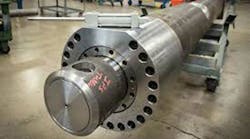With modern sealing technology, the volumetric efficiency (leakage losses) of a hydraulic cylinder in good condition approaches 100%. But the mechanical-hydraulic efficiency of a cylinder varies with seal type and the tolerances between the piston-rod and its wear bands.
Recall that mechanical-hydraulic efficiency refers to the amount of force lost due to mechanical and fluid friction. In a cylinder, these losses are due to friction between the piston-rod and its wear bands and seals, and the friction of the fluid as it's ejected from the return side of the cylinder at the required velocity. In practice, fluid friction is not significant, provided the cylinder's ports and its connections are adequately sized.
For a single-rod cylinder when extending, mechanical-hydraulic efficiency is typically 95%, and 85% to 90% when retracting. The difference between extension and retraction reflects the fact that mechanical/hydraulic friction is nearly constant, and it therefore represents a greater percentage of available force when the cylinder is retracting--due to the smaller effective area of the rod-end annulus.
For example, consider a single-rod cylinder with an area ratio (piston to annulus) of 2:1. If piston force (during extension) is 10,000 lbf (44 kN) and annulus force (during retraction) is 5,000 lbf (22 kN), and losses due to mechanical and fluid friction are 500 lbf (2.2 kN) constant. Then:
Mechanical-hydraulic efficiency during extension is:
1 - (500/10000) = 1 - 0.05 = 0.95 = 95%
And mechanical-hydraulic efficiency during retraction is:
1 - (500/5000) = 1 - 0.1 = 0.90 = 90%
Overall efficiency is simply the product of volumetric and mechanical/hydraulic efficiency. In a modern hydraulic cylinder, where volumetric efficiency approaches 100%, overall efficiency equals mechanical/hydraulic efficiency: 0.95 x 1 = 0.95 = 95%.
Are you making any of these mistakes with your hydraulic equipment? To find out for sure, get "Six Costly Mistakes Most Hydraulics Users Make... And How You Can Avoid Them!" available for FREE download here.

Continue Reading
Continue Reading
How To Test A Hydraulic Cylinder
Feb. 3, 2016
Cylinder and Valve Sizing
Aug. 8, 2019
Sponsored Recommendations
Sponsored Recommendations
All-In-One DC-UPS Power Solutions
March 13, 2024
Motor Disconnect Switches
March 13, 2024
Industrial Straight-Through Cable Gland
March 13, 2024
